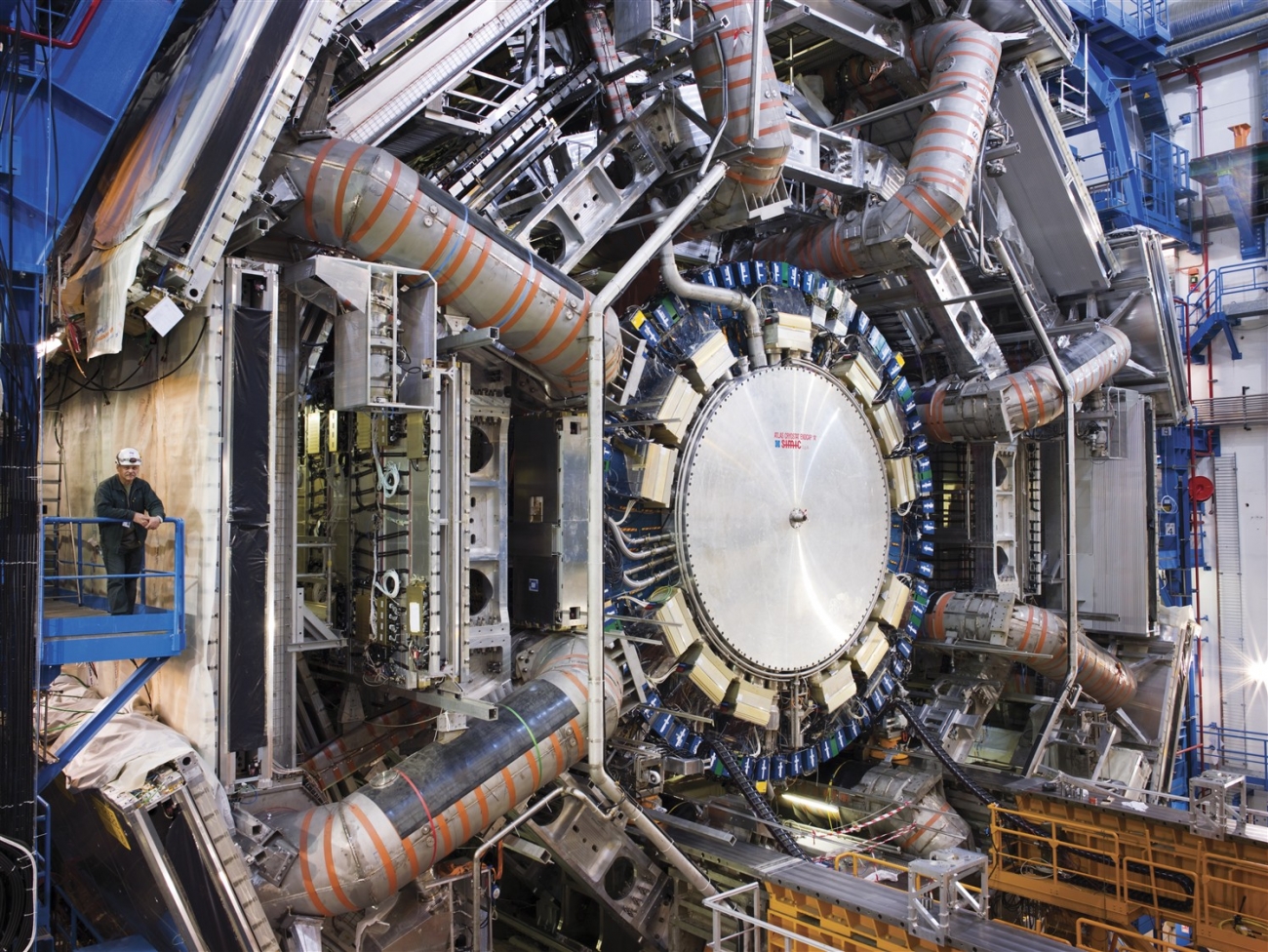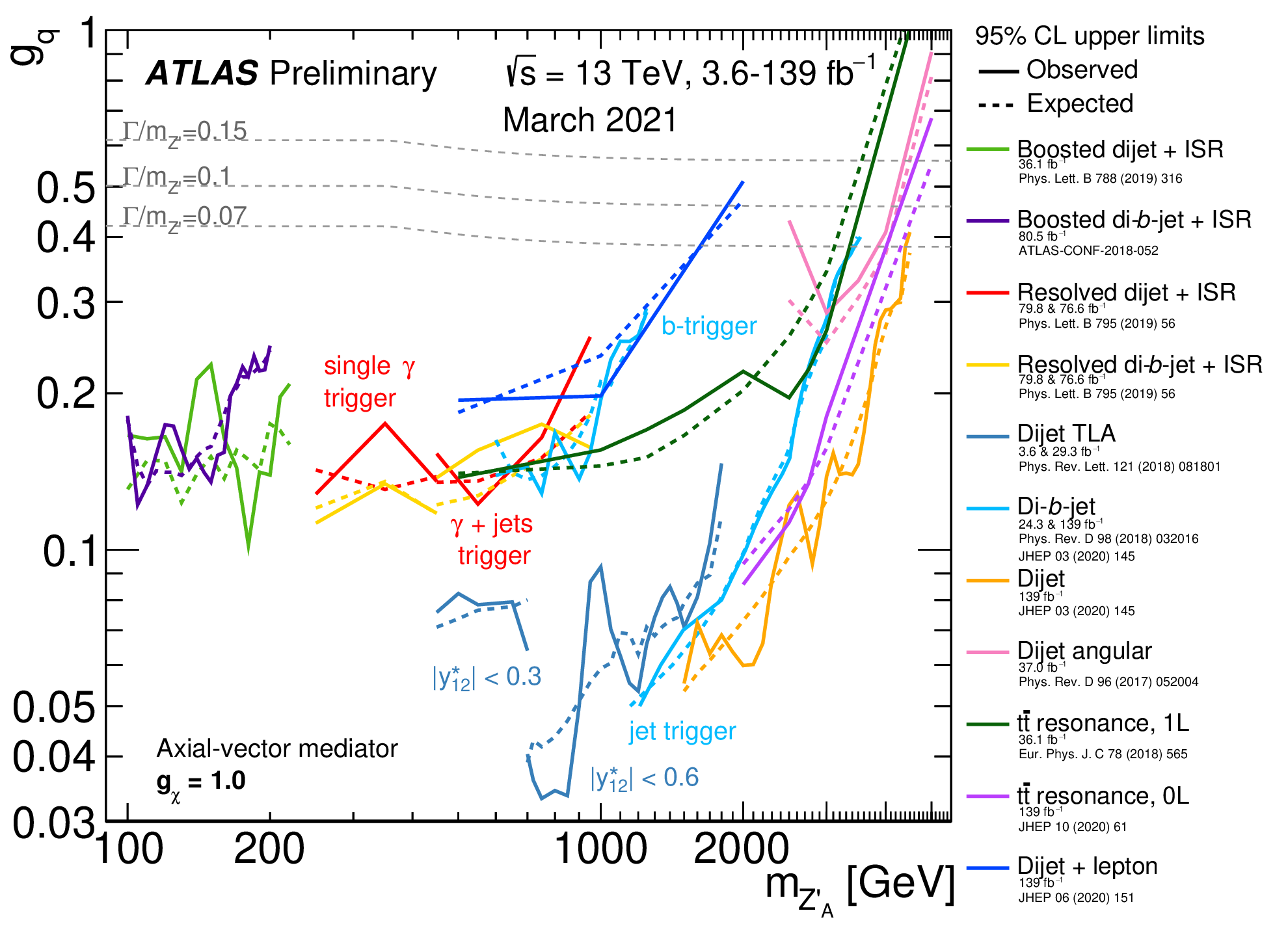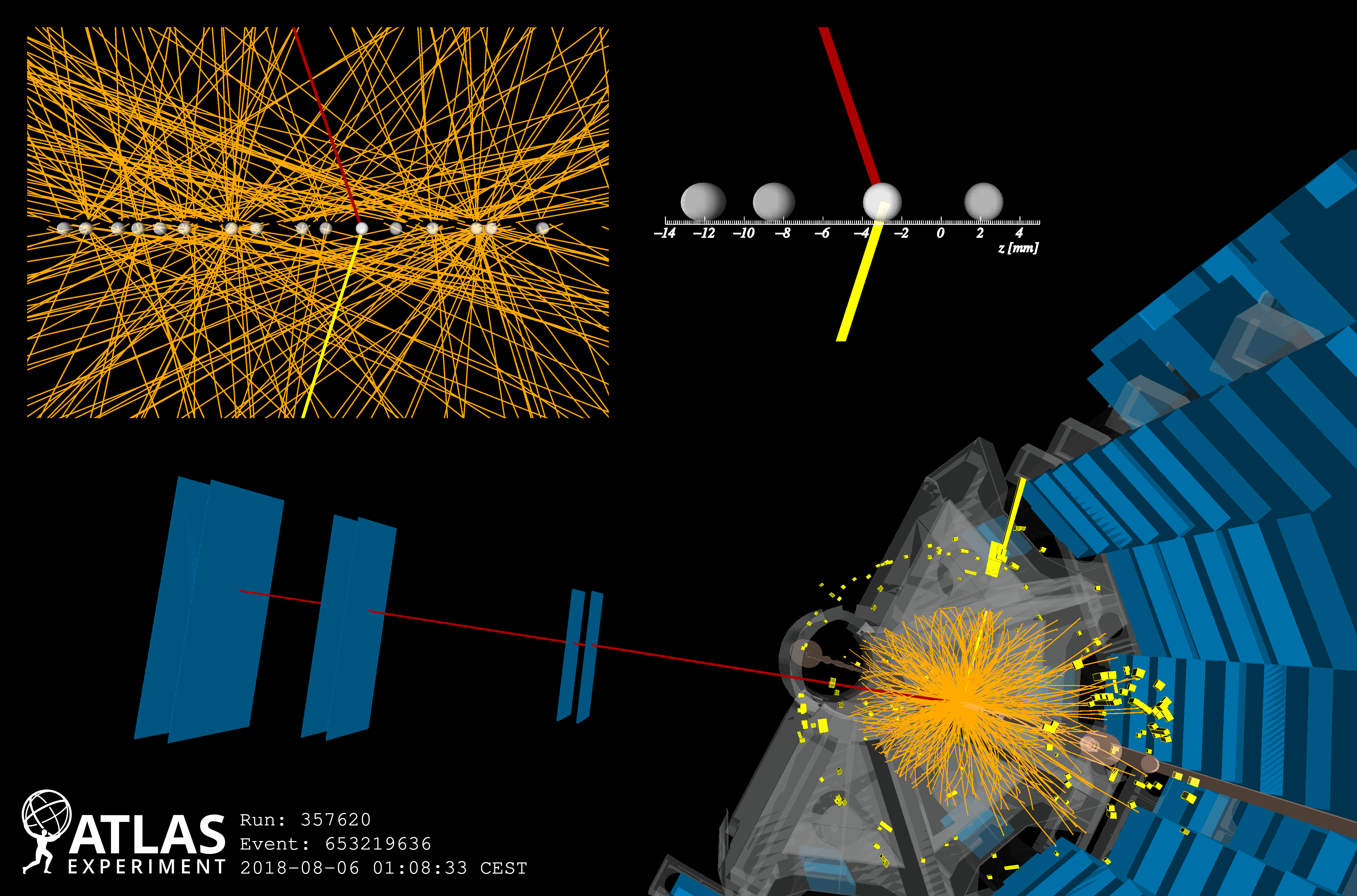ATLAS faces the challenge of Run 3

The ATLAS experiment is a general-purpose particle detector operating at the LHC. It consists of several concentric layers of particle detectors occupying a cylindrical volume 46m long and 25m in diameter. The innermost detectors reconstruct the trajectories of charged particles produced in the beam collisions with high precision. They are surrounded by a 2T solenoidal magnet as well as by electromagnetic and hadronic calorimeters designed to measure the energy of charged and neutral particles emanating from the collisions. The outermost component is the muon spectrometer which includes three toroidal magnet systems and precision chambers to reconstruct the trajectories of muons. Signals from the various detectors are processed by a trigger system consisting of both hardware and software stages to reduce the data collection rate to about 1kHz.
The ATLAS experiment has been in operation since the start of the LHC, collecting proton-proton collision data at 7 TeV and 8 TeV during Run 1, and at 13 TeV during Run 2. Proton-lead, lead-lead, and xenon-xenon collisions were also recorded during those running periods. Multiple upgrades of the detector and trigger systems as well as computing and software developments are underway in preparation for the exploitation of opportunities presented by future data taking in Run 3. Highlights of the physics program include the discovery of the Higgs boson in 2012, in addition to a vast array of Standard Model measurements and searches for phenomena beyond the Standard Model.
In the past years, the ATLAS collaboration has actively pursued a number of searches for new phenomena, covering a large part of the available parameter space available at the energies of the LHC. 2020 saw excellent successes for the ATLAS Collaboration, including first-of-a-kind physics results and great headway made on detector upgrades. We interview Stephane Willocq, ATLAS Physics Coordinator, about ATLAS future plans in light of LHC’s Run 3. In the beginning of our discussion he notes “We have performed a lot of searches for new physics that could be realized at the TeV scale in line with the original motivation for the LHC’s physics programme”. Searching for new physics with the data collected from the previous runs of the LHC has been a key focus for the LHC experiments.
The Standard Model is an extremely successful theory and yet leaves open many questions. Perhaps, one of the key questions that motivates searches for new phenomena is the so-called hierarchy problem; namely the fact that there is a large gap between the electroweak scale (i.e. the typical energy of processes described by the electroweak theory) and the Planck scale. The difference between these two different energy scales, almost by 17 orders of magnitude, remains one of the deeper mysteries for particle physics. This discrepancy is linked to the observed light Higgs boson with a mass roughly 1017 times smaller than might have been expected in the Standard Model. “If you take into account all the quantum/radiative corrections, the Higgs mass should be as large as the Planck scale about 1019 GeV and yet we experimentally found it to be 125 GeV” explains Stephane and continues “unless you have some kind of new physics entering at the TeV scale, the Higgs boson should be much heavier than what was discovered in 2012”.
Addressing the hierarchy problem has been one of the main drivers for previous searches at the LHC. One of the ways to naturally account for this large discrepancy is by introducing supersymmetry, a new symmetry that could rotate bosons into fermions and vice versa and thus introduce new particles that could balance the radiative corrections to the mass of the Higgs boson. Supersymmetry is one of the most attractive theories to solve the shortcomings of the Standard Model tackling both the hierarchy problem but also providing good Dark Matter candidates. Therefore, a large part of LHC searches focused on supersymmetric particles and over the years we had a chance to optimize both the experimental as well as theoretical tools. However, the latest results from the full dataset exclude a large part of the region of the parameter space where SUSY could solve the hierarchy problem, provide DM candidates and pave the way to unification. Learning from these results, we currently optimize our analysis strategies to cover the more difficult areas of the phase space, and upgrade our detectors to acquire the needed sensitivity. The results of searches for a supersymmetric partner of the top quark (top squark) which provides a solution to the hierarchy problem are shown in Figure 1.

Figure 1: Limits from searches for the top squark as a function of its mass and the mass of the lightest supersymmetric particle (in this case the neutralino). The filled regions are excluded at 95% confidence level.
ATLAS has also performed a number of dedicated searches for other scenarios beyond the Standard Model (BSM). This includes the search for heavier bosons like the Z’ and W’ bosons that arise from extensions of the electroweak symmetry of the Standard Model, the search for an extended Higgs sector as well as the search for signs of composite Higgs. “We have thoroughly searched for signals that could point to one of the scenarios and yet no sign of new physics has been found to date. This is perhaps one of the biggest lessons that we got from the previous runs of the LHC that allowed us to cover a large part of the parameter phase space of these theories. Results from Run 1 and Run 2, verified that our original hypotheses to tackle the shortcomings of the Standard Model are not realised in nature and thus we need to search for different solutions”.
When combined, ATLAS Higgs boson measurements give detailed insight into this one-of-a-kind particle, significantly outperforming previous measurements. The overall production rate of the Higgs boson found to be in good agreement with the Standard Model, within a measurement precision of 5% and about 4% uncertainty in the Standard Model prediction. Though the Standard Model remains unperturbed, the exploration is just beginning! Some important but difficult analysis channels are still to use the full Run-2 dataset – offering additional insight into the Higgs boson’s secrets.
Perhaps, nature is more fine-tuned than we previously thought and the mechanism that screens the Higgs mass from the quantum corrections lies at the scale of 10 TeV or perhaps a bit higher, beyond our current direct experimental reach. This scenario would require some fine adjustments to get the experimentally measured Higgs mass but they could well fit in our theoretical framework. Stephane explains that “if new physics lie beyond the reach of the LHC you will not observe a nice clean bump in your data, but there are still ways to look for it through indirect searches”. One should also note that the discovered Higgs boson itself calls for further study since it comes with a unique setup of interactions, depending on the mass and not being universal. “The Higgs that we discovered is truly unique with respect to all the other particles that we know in particle physics. It is a fundamental particle with spin-0 and with no electric charge. This is so unusual compared to what we know and there is no reason that there should be only one rather than a whole family of such bosons.” The good news is that if a family of Higgs bosons exists, we don’t expect its other members to be very heavy and they may be within the experimental reach of the LHC.
There are two main ways to approach this problem. “The first is to follow a more indirect path, which is what we plan for analyzing data from Run 3 and the HL-LHC phase. The goal is to measure more precisely Standard Model processes that could reveal hints about possible new physics lying at higher energy scales”. ATLAS plans to refine measurements of the Higgs or W boson production, continue searches for dibosons resonances as well as measurements, and pursue a rigorous top quark programme. “Precise measurements of these quantities can be interpreted in the context of Effective Field Theories (EFT) and give us a hint as to where new physics could lie”. EFTs is a useful tool, allowing to parametrize the effect of new physics lying at higher energy scales in terms of deviations from the SM measurements. “There is a growing interest by the LHC experiments to collect these precise measurements and put them in a common framework that allows to extract the most information out of the collected data”.
A second possibility is that new physics may be hiding, interacting very feebly with the Standard Model particles, and we should rethink our way of looking/interpreting the data. “Instead of focusing only on pushing toward higher energies, the new physics is not heavier but lighter. This means that we should push what we call the coupling frontier and search for weakly interacting new phenomena with very low coupling strength.” tells us Stephane and adds “This is something that we have been exploring for some time and I believe that searches in this frontier will further develop during Run 3.” Figure 2 provides an illustration of how searches for hadronic resonances are pushing towards both higher energies (horizontal axis) and lower coupling strength (vertical axis) over a wide range of resonance mass.

Figure 2: Limits on searches for hadronic resonances as a function of Z’ resonance mass and Z’ coupling to quarks. The regions above the curves are excluded at 95% confidence level. Many channels are explored that are optimized to cover different mass and coupling parameters.
In spite of the global pandemic, 2020 has been a very productive year for the ATLAS collaboration. In 2020, the ATLAS experiment also announced the first indications of a Higgs boson decay to two muons, a rare process within the Standard Model as only about one Higgs boson in 5000 decays into muons. Moreover, during 2020, results from the ATLAS Collaboration focused on different production modes of the Higgs boson decaying into b-quarks.The new analyses profit from the power of machine learning to better discriminate this particular process from other proton collision events. ATLAS also explored the CP nature of the effective coupling between the Higgs boson and gluons. The study of this production mechanism is an excellent way to search for signs of CP violation, as it affects the Higgs-boson kinematics, leaving a trace in the azimuthal angle between the jets measured by ATLAS
Another highlight of 2020 is related to the photon production in proton–proton collisions. Direct evidence for light-by-light scattering at high energy had proven elusive for decades, until the Large Hadron Collider (LHC) began its second data-taking period (Run 2). The first direct evidence of light-by-light scattering was reported by ATLAS in 2017, exploiting the strong electromagnetic fields surrounding lead ions in high-energy lead–lead collisions. In 2019 and 2020, ATLAS further studied this process by measuring its properties.

Figure 3. The four force-carrier interaction is one of the predictions of the electroweak theory that explains how force-carrier particles, also known as gauge bosons, interact not only with matter particles, but also with one another.
In ICHEP 2020, the ATLAS Collaboration also announced the first observation of two W bosons produced from the scattering of two photons — particles of light. The newly observed process proceeds via a very rare type of phenomenon where two photons collide to directly produce two W bosons of opposite electric charge via a four force-carrier interaction, among others (see Figure 3. Although the ATLAS and CMS Collaborations saw first evidence of this process in data recorded during Run 1 of the LHC (2011–2012), its observation required the substantially larger dataset taken during Run 2 (2015–2018). The four force-carrier interaction is an integral part of electroweak theory and, at the same time, can be sensitive to modifications of the Standard Model by unaccounted-for new physics. The experimental techniques presented by the ATLAS Collaboration will enable future measurements that can probe such modifications and test the electroweak theory in a novel way. Finally, another interesting process studied during Run 2 is the ttZ production that provides a benchmark test for the Standard Model. It allows physicists to directly probe the electroweak interaction between the Z boson and the top quark, sharing complementarity of information with the related top-pair production with the Higgs boson. ATLAS physicists studied the full dataset collected during Run 2 of the LHC for a precise measurement of its cross section. Although this latest analysis does not hint towards new phenomena, the next 15 years will see the LHC provide 20 times the number of collisions seen thus far. Such a yield will significantly increase ATLAS’ statistical precision and sensitivity. Another highlight of the ATLAS physics programme include the first evidence for the production of four top quarks. "This is a great example of a rare process that can now be studied thanks to the large Run 2 dataset." notes Willocq. Finally, another interesting result illustrating the power of large datasets is the precise measurement of the relative branching fraction of top quarks decaying to pairs of W bosons, and subsequently into leptons one of the oldest tensions in the Standard Model. ATLAS collaboration measured the relative probability that this lepton is a muon or a tau-lepton – a ratio known as R(τ/μ). According to the Standard Model, R(τ/μ) should be unity, as the interaction strength with a W boson should be the same for a tau-lepton and a muon. But there has been long-standing tension with this prediction, ever since experiments at the Large Electron-Positron (LEP) collider in the 1990s measured R(τ/μ) to be 1.070 ± 0.026, deviating from the Standard Model expectation by 2.7 standard deviations. This result motivated a new measurement with higher precision. "We performed a 1.3% measurement of this ratio which is twice as precise as that achieved by LEP and also resolved a 2.7 sigma discrepancy between the LEP measurement and the SM prediction."
A number of ATLAS searches during Run 3 will look for relatively low mass new particles that have smaller cross section/lower production rate. Some of these particles may also be good candidates for dark matter which is another of the biggest questions in fundamental physics. “We think that there might be a so-called dark or hidden sector that communicates with the Standard Model via an intermediate particle that provides some kind of portal. The Higgs boson could play this role, also given its unique properties compared to all the other known particles of the Standard Model”. Other models predict a vector portal based on the idea of a new kind of photons called dark photons. They can be light, with masses in the range of 1-10 GeV, and thus if they exist they could be produced at the LHC, though with a small production rate. These are only few of the possibilities that fall within the coupling frontier that is expected to gather more attention in the upcoming run of the LHC.
Indeed, dark matter is another experimental evidence pointing to the existence of new physics beyond the Standard Model. “There is strong astrophysical evidence for the existence of dark matter. Moreover, DM could be linked to new particle species though this remains the leading interpretation as there are also alternative hypotheses. However, if DM is related to particles we believe that they may be fairly light and within our current experimental reach”. In 2020 ATLAS presented some of the more precise DM searches placing stringent limits on a number of theoretical models.
ATLAS has already accumulated a significant amount of data at 13 TeV and the hope is that during the next run, the LHC will give access to the 14 TeV regime. “This is a small gain in energy, compared to what is envisioned for next generation colliders, but could shed light on where new physics lies”. Given the relatively small increase towards higher energies, Stephane believes that the next run of the LHC will also cover a lot of ground on the coupling frontier and give us more sensitivity on still unobserved weakly-coupling processes. “I expect that this frontier will grow along with searches for phenomena that are difficult to observe like long-lived particles. Many of our searches focused on particles that decay almost instantaneously in our detector. However, there is no reason that some of these particles cannot have longer lifetimes and could travel a few centimeters or even meters before decaying. Searches towards this direction will probably grow in the next run”.

Figure 4: Upper limits on the cross section for WIMP-nucleon interactions as a function of WIMP mass. The constraints from the search for Higgs boson decays into invisible particles is compared with those from direct detection experiments.
Last but not least, a number of searches on leptoquarks that could explain the same number of generations for leptons and quarks will carry on, taking forward recent lessons from Run 2 of the LHC. The same also applies for searches of ALPs or WIMPs both well motivated by current theoretical or experimental understandings. Stephane notes at the end of our discussion that the interpretation of results from Run 3 will call for greater synergy with astrophysics as well as direct detection/underground experiments; this could help verify any new results or define future search strategies and the design of the next generation of scientific tools that could give us answers to some of the outstanding questions in modern physics. The searches for decays of the Higgs boson into invisible particles may be interpreted in the context of DM models and compared with direct searches for WIMPs, as shown in Figure 4. These illustrate the complementarity between collider and direct searches.
Follow the ATLAS Experiment Physics Briefings and get the latest results: ΗΕRΕ
